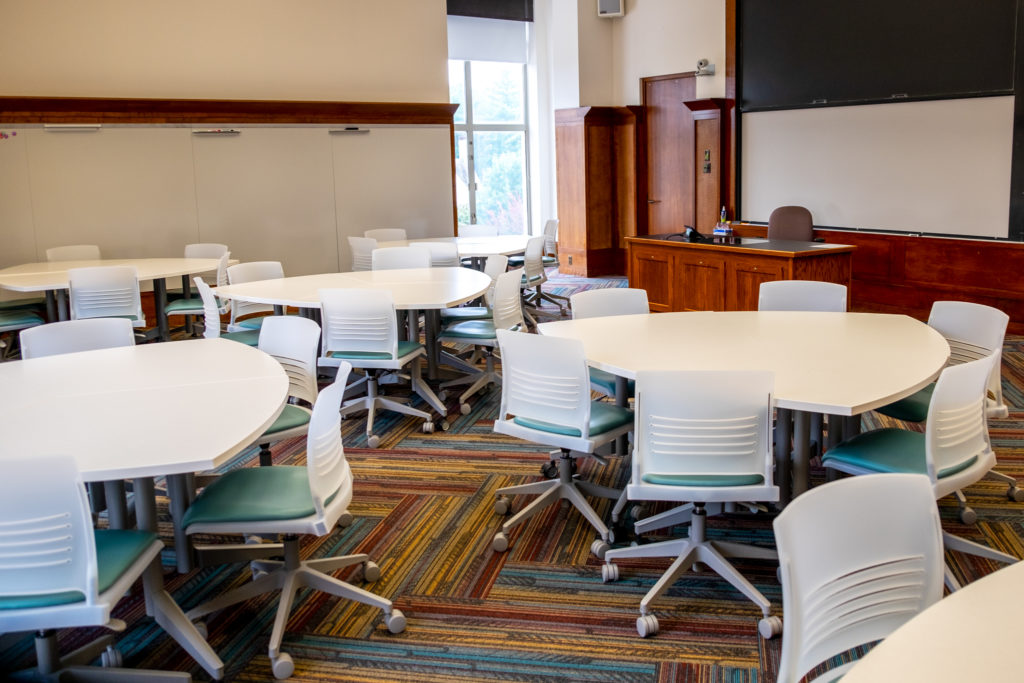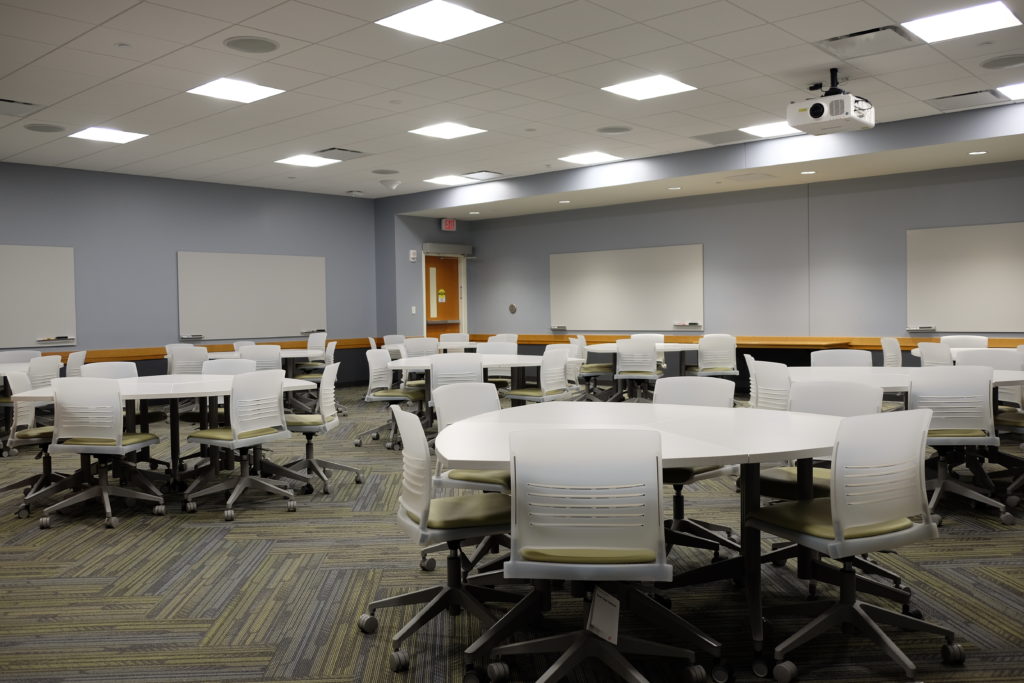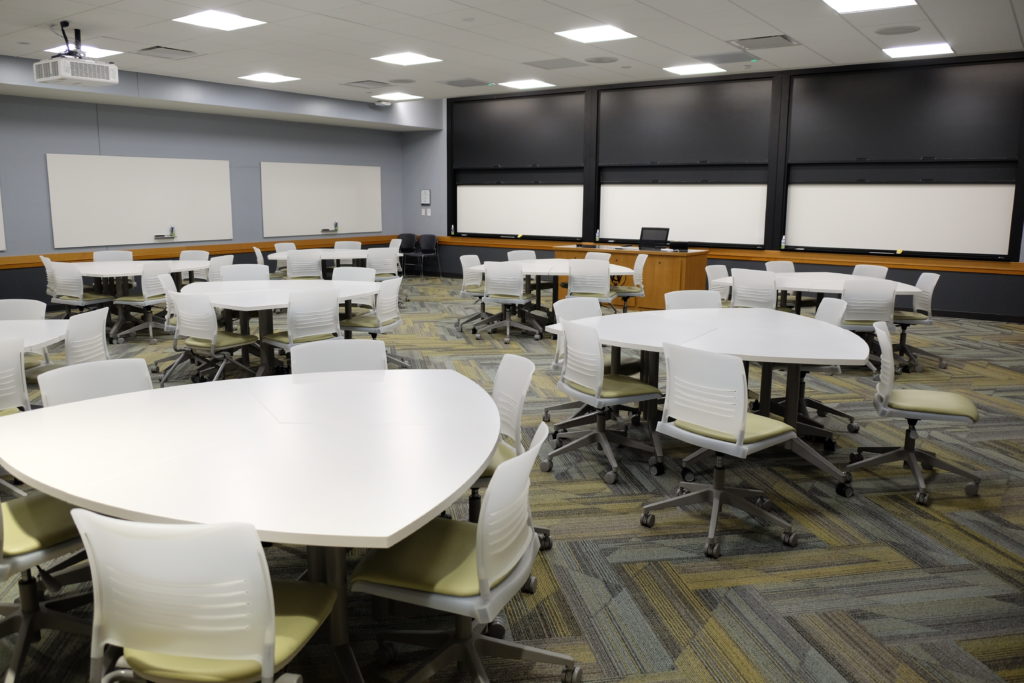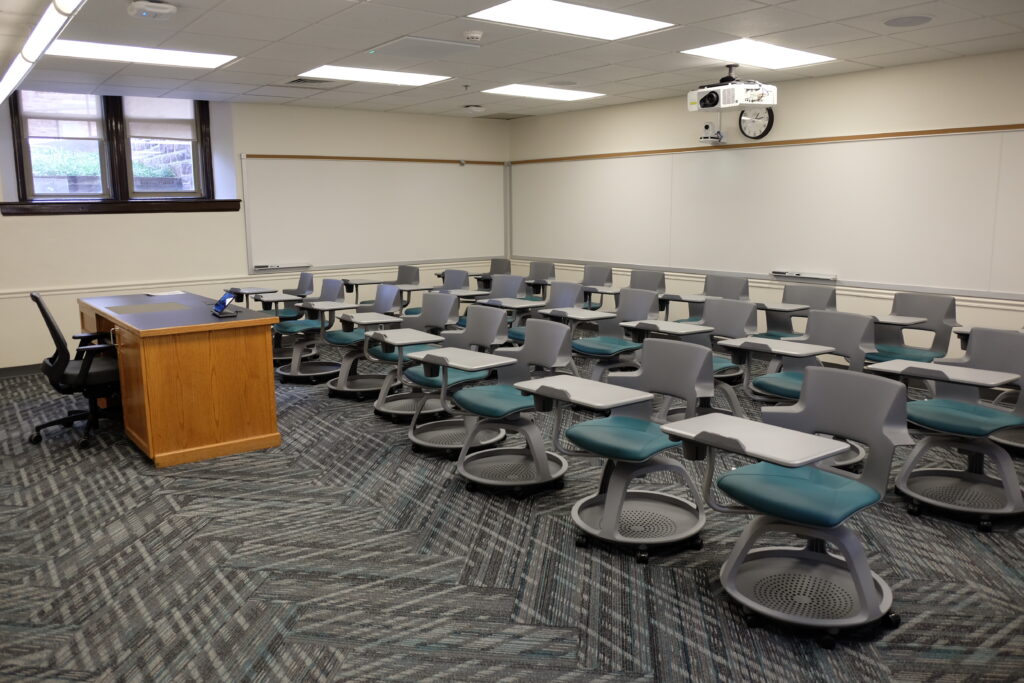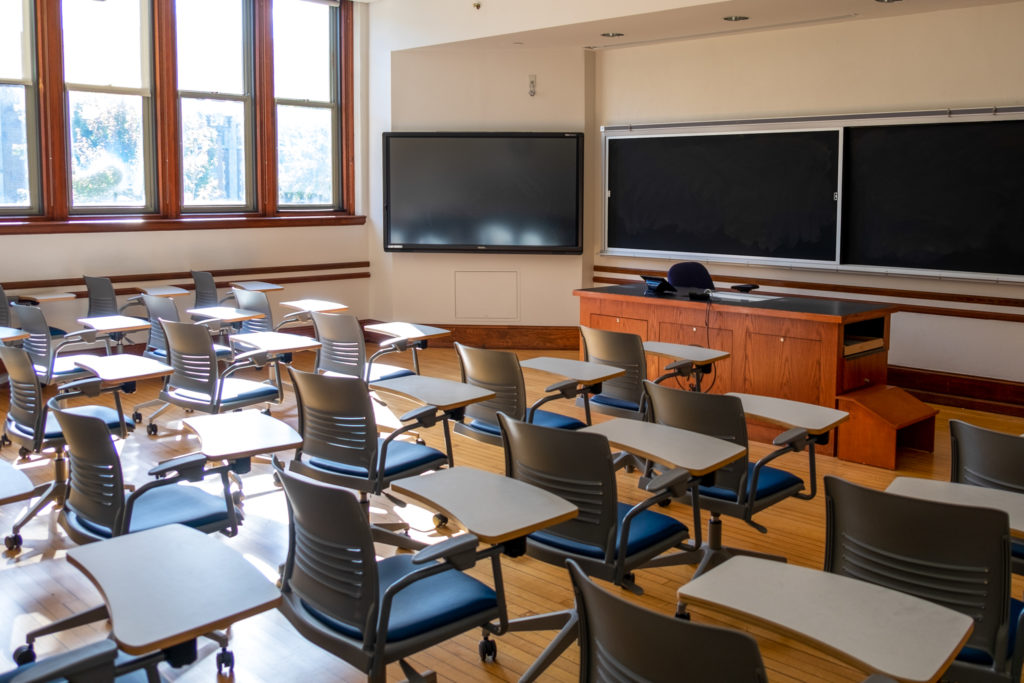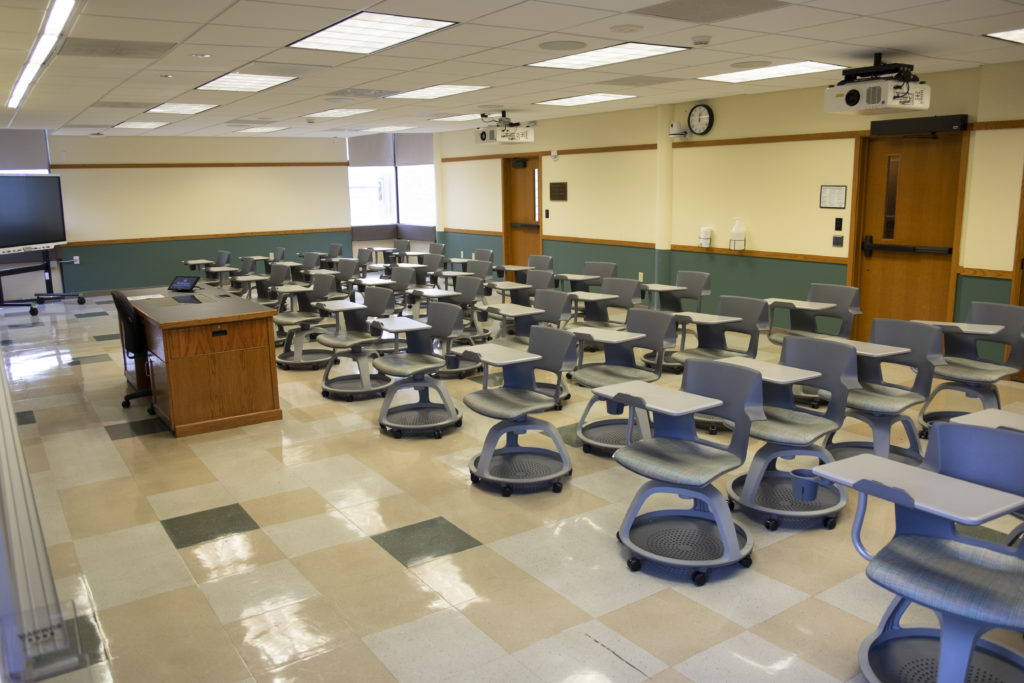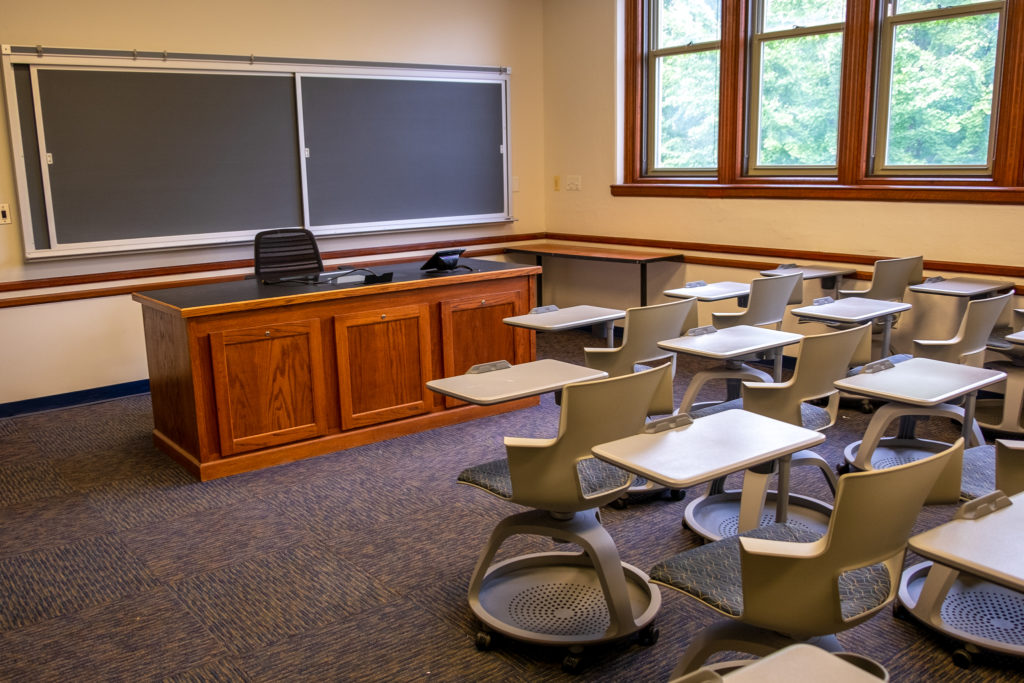Active Learning Classrooms
Spaces Designed for Collaborative Learning
Student-centered, technology-rich spaces that bring your teaching to life.
The Center for Teaching and Learning designs, manages, and supports several WashU classrooms that make collaborative learning among students and instructors effortless. These active learning classrooms (ALCs) include TechPod classrooms with cutting-edge technology as well as Roundtable and Flexspace classrooms that focus on student interaction.
TechPod classrooms are designed to promote student collaboration with tables that seat students in pods with screen sharing via monitors situated at each pod. If your students will solve problems, review presentations, or work on digital materials/projects together, request one of our TechPod classrooms: January 110, or Eads 016.

January 110: Seats up to 60 students.
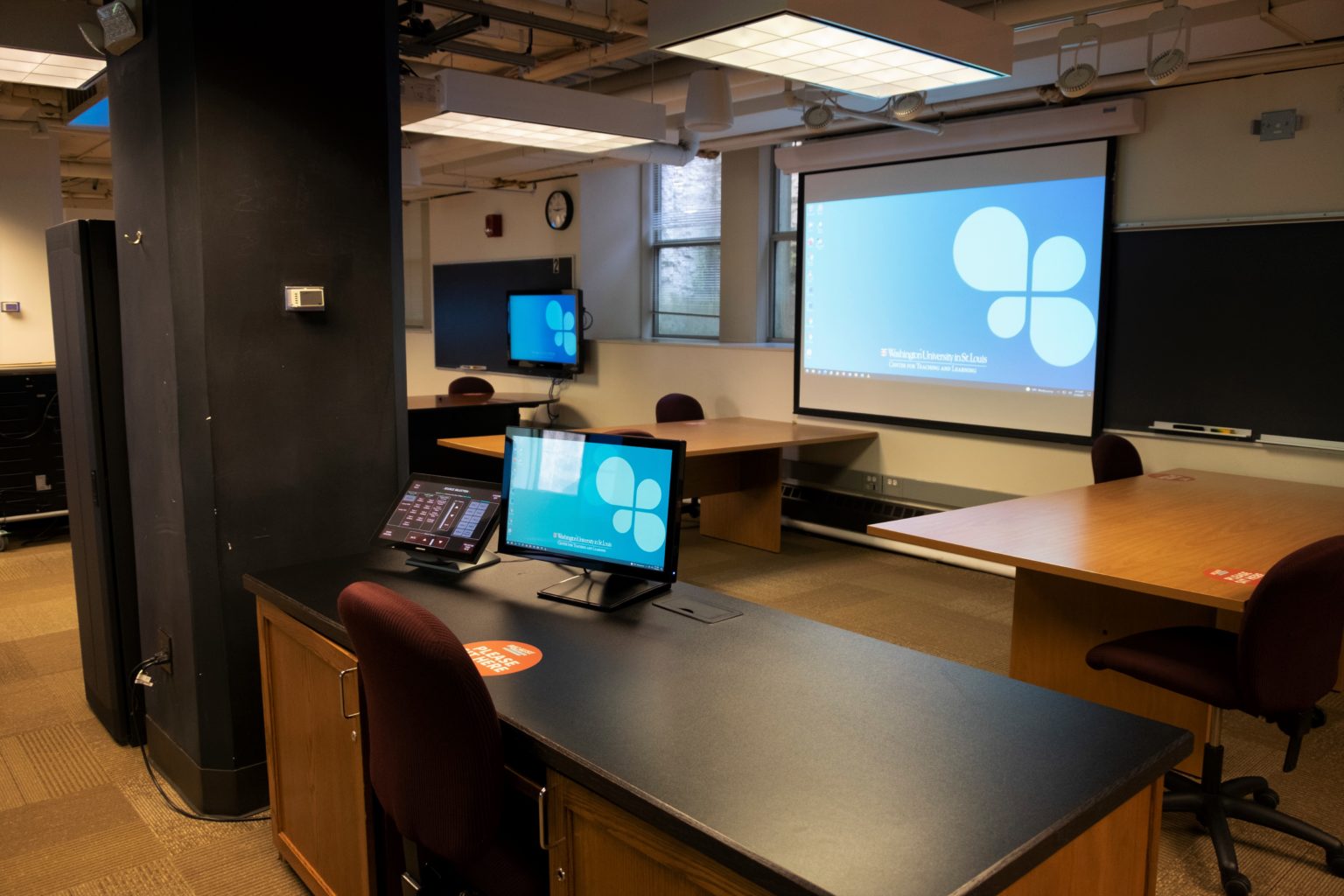
Eads 016: Seats up to 54 (ALC) or 125 (lab) students.
Roundtable classrooms feature student pods in moveable tables, standard classroom technology, and whiteboards around the room, but do not have monitors at each pod. These classrooms are perfect for facilitating collaborative learning in smaller classes in which students regularly collaborate in small groups. Learn more about one of the following Roundtable rooms: McDonnell 361, McDonnell 362, Simon 017, Simon 18, Seigle 304, Somers Family Hall 249.
Flexspace classrooms feature standard classroom technology and chalk/whiteboards, with rolling chairs that have attached tablet desks. These chairs allow students to freely rotate and move around the room so that they can engage with one another in different configurations. Request one of the following Flexspace rooms for smaller classes where you want to easily facilitate discussion and collaboration between students: Duncker 1, Eads 211, Eads 116, Mallinckrodt 305.
Submit a request for these classrooms on the OUR website. For questions and technical support, email us at ctl@wustl.edu, schedule a consult, or call 314-935-6810. The CTL can provide technology training, pedagogical consulting, and on-going support for all classrooms.
You can also get ideas for teaching in an ALC or join a faculty learning community focused on ALCs by contacting us at ctl@wustl.edu.
Active Learning Spaces
Check them out!
Why teach in ALCs?
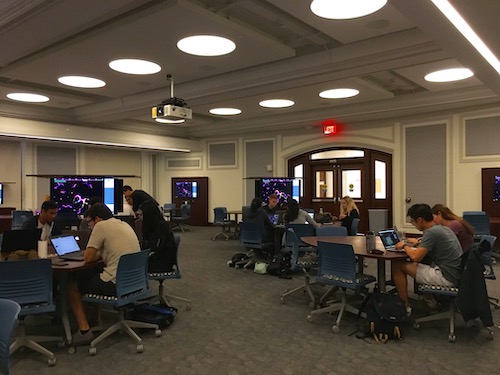
Research articles from prominent scholarly journals and higher education centers highlight the benefits of an ALC. Students who learn in an ALC have better attitudes, conceptual understanding, and passing rates. Research has shown that learning in an ALC also improves students’ exam grades and satisfaction (Baepler 2016). In 2017, an EDUCAUSE Center for Analysis and Research report named ALCs its top strategic technology.
ALCs at schools including Yale, MIT, University of Minnesota, and Washington University in St. Louis are largely modeled after SCALE-UP, a classroom designed at North Carolina State University in the mid-1990s to facilitate active learning.
ALCs can be particularly useful in lecture courses. Researchers at the University of Minnesota looked at how ALCs impact student learning in large introductory biology courses. The same instructor taught the course in two rooms, an ALC and a traditional classroom, with the same course outline and pedagogical approaches. The research shows that ALCs positively affect student learning by improving student performance and engagement (Cotner 2013).
Another study from researchers at Harvard University published in 2019 shows that even though students felt that they learned more from traditional lectures, they actually learn more when taking part in classrooms that employ active learning strategies. Active learning classrooms are a great conduit for employing these strategies.
“Active Learning Classrooms show how physical space can impact instruction in a positive way. When students face each other instead of the instructor they can interact much more easily. From an instructor’s standpoint, it is more natural to incorporate student-centered activities into a class when the physical space allows for that flexibility,” said Eric Fournier, Director of Educational Development at the Center for Teaching and Learning at Washington University in St. Louis.
BILL LOWRY, PROFESSOR OF POLITICAL SCIENCE
"January 110 has been a godsend for the Sustainability Exchange. We started doing this course in 2015 and for years we tried different venues, including the Academy Building. Once January 110 was open, we felt like we had a home. The room setup is perfect for our course. We typically have five or six project teams and each group uses one of the stations in the room. We use this format even when someone is leading a seminar and has the teams do exercises within the groups."
Physical Space
Physical space plays an important role in active learning classrooms. In A Guide to Teaching in the Active Learning Classroom by Baepler et. al. (2016), authors write that ALCs
“typically feature round or curved tables with moveable seating that allow students to face each other and thus support small-group work. The tables are often paired with their own whiteboards for brainstorming and diagramming. Many tables are linked to large LCD displays so students can project their computer screens to the group, and the instructor can choose a table’s work to share with the entire class.”
CLAIRE M. CLASS, POSTDOCTORAL FELLOW, DEPARTMENT OF ENGLISH
"The classroom in McDonnell 362 has new mini-whiteboards around the walls, which allow student groups to work through problems and share their work. These are extremely helpful teaching tools."
ANTHONY J. SMITH, ASSISTANT DEAN & ACADEMIC COORDINATOR, COLLEGE OF ARTS & SCIENCES
"The room has been great. It worked out well for our ‘Biology of Cancer’ class. We have utilized the multiple whiteboards for student group activities and the mobile tables and chairs to move things around the room for whole-class activities and games. The multimedia capabilities worked well for various types of lecture presentations. I hope to use the room again next fall."
- Helpful Resources
-
- Find inspiration for your ALC via North Carolina State University’s SCALE-UP project
- See an ALC in action on the University of Minnesota’s website
- Get more information on designing and utilizing ALCs from the University of Minnesota
- Read A Guide to Teaching in the Active Learning Classroom: History, Research, and Practice. Ed. Baepler, P, Walker, J.D., Brooks, D.C., Saichaie, K, and Petersen, C. 2016. Sterling, VA: Stylus.
- Learn more about ALCs from Yale’s Center for Teaching and Learning
- Check out TILE, the University of Iowa’s approach to ALCs
- References
-
- Baepler, P, Walker, J.D., Driessen, M. “It’s not about seat time: Blending, flipping, and efficiency in active learning classrooms.” Computers & Education 78 (2014), 227-236.
- Baepler, P, Walker, J.D., Brooks, D.C., Saichaie, K, and Petersen, C. (2016). A Guide to Teaching in the Active Learning Classroom: History, Research, and Practice. Sterling, VA: Stylus.
- Brooks, D. C. 2012. Space and Consequences: The Impact of Different Formal Learning Spaces on Instructor and Student Behavior. Journal of Learning Spaces 1.2.
- Cotner, S., Loper, J., Walker, J.D., & Brooks, D.C. (2013). ’It’s not you, it’s the room’ (Or, are the high-tech, active learning classrooms worth it?). Journal of College Science Teaching 42(6), no pagination. (Picked as Editor’s Choice, Science, Vol. 341, 23 August 2013.)
- Deslauriers, L., McCarty, L., Miller, K., Callaghan, K., Kestin, G. 2019. Measuring actual learning versus feeling of learning in response to being actively engaged in the classroom. PNAS, 116 (79), 19251-19257.
- Soneral, P. &, Wyse, S. (2017). A SCALE-UP mock-up: Comparison of student learning gains in high- and low-tech active-learning environments. CBE—Life Sciences Education, 16(1).
- Walker, J. D. 2011. Pedagogy and Space: Empirical Research on new Learning Environments. EDUCAUSE Quarterly, 34.
